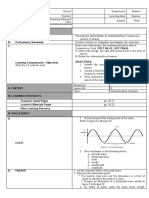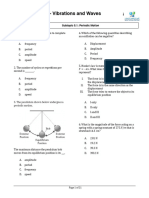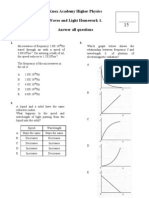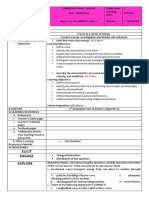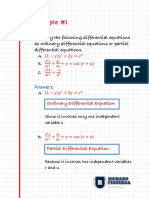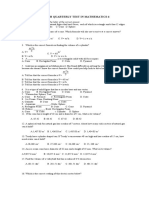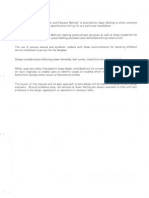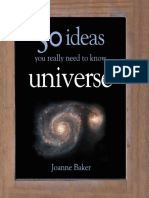Which Set of Waves Shown Below Is in Order From Highest To Lowest Frequency? A
Which Set of Waves Shown Below Is in Order From Highest To Lowest Frequency? A
Uploaded by
faithinhim7515Copyright:
Available Formats
Which Set of Waves Shown Below Is in Order From Highest To Lowest Frequency? A
Which Set of Waves Shown Below Is in Order From Highest To Lowest Frequency? A
Uploaded by
faithinhim7515Original Title
Copyright
Available Formats
Share this document
Did you find this document useful?
Is this content inappropriate?
Copyright:
Available Formats
Which Set of Waves Shown Below Is in Order From Highest To Lowest Frequency? A
Which Set of Waves Shown Below Is in Order From Highest To Lowest Frequency? A
Uploaded by
faithinhim7515Copyright:
Available Formats
North Carolina Testing Program EOC Physics Sample Items Goal 7
1. Which set of waves shown below is in order from highest to lowest frequency?
1 second 1 second 1 second
1 second 1 second 1 second
1 second 1 second 1 second
1 second 1 second 1 second
Published January 2008. May reproduce for instructional and
Page 1 educational purposes only; not for personal or financial gain.
North Carolina Testing Program EOC Physics Sample Items Goal 7
2. What is the period of the wave shown below?
1.0 sec
Time
A 0.10 s
B 0.40 s
C 1.0 s
D 2.5 s
3. Assuming the waves all have the same velocity, which wave has the lowest frequency?
A B
Time Time
C D
Time Time
Published January 2008. May reproduce for instructional and
Page 2 educational purposes only; not for personal or financial gain.
North Carolina Testing Program EOC Physics Sample Items Goal 7
4. What is the period of a wave that has 6. A physicist measures the speed of an
a wavelength of 0.80 m and is electromagnetic wave as 1.3 × 108 m/s
traveling at 2.0 m/s? in a medium. What is the index of
refraction of the medium?
A 0.40 s
A 0.43
B 0.63 s
B 2.3
C 4.0 s
C 2.5
D 6.3 s
D 3.9
5. A student sits on one side of a door
sending a horizontal pulse along a 7. In which media would sound waves
rope that runs under the door. The travel fastest?
reflected pulse is inverted. What
information can be inferred from this A a vacuum
observation?
B air
A The rope is unattached.
C water
B The rope is attached to a rigid
boundary. D glass
C The rope is attached to a more
flexible boundary.
D The rope is attached to a
boundary that has equal rigidity
as the rope.
Published January 2008. May reproduce for instructional and
Page 3 educational purposes only; not for personal or financial gain.
North Carolina Testing Program EOC Physics Sample Items Goal 7
8. A pulse travels from a spring to a thin 9. A light ray is incident on a plane
thread that is attached to a wall. mirror as shown in this diagram.
Light Ray
A thread
Air Air
Mirror
What is the angle of reflection?
A 0°
Which best describes the pulse in the
thread after it leaves the spring at B 30°
point A?
C 45°
A The pulse is upright.
D 90°
B The pulse is inverted.
C The pulse stops.
D The pulse is totally reflected with
no transmission.
Published January 2008. May reproduce for instructional and
Page 4 educational purposes only; not for personal or financial gain.
North Carolina Testing Program EOC Physics Sample Items Goal 7
10. A child is playing with a string
attached to a doorknob. She sends a
series of pulses down the string.
Assume that the pulses are reflected
with no loss of amplitude. If all the
pulses have an amplitude of 15 cm,
which best describes what the child
sees where an incident pulse and
reflected pulse meet?
A a larger pulse of 30 cm
B a smaller pulse of 15 cm
C Both pulses are seen on either
side, each with an amplitude of
15 cm.
D No pulse is seen where the two
pulses meet.
Published January 2008. May reproduce for instructional and
Page 5 educational purposes only; not for personal or financial gain.
North Carolina Testing Program EOC Physics Sample Items Goal 7
11. Two wave pulses are traveling on a rope in opposite directions, as shown in the diagrams.
The wave pulses have the same length and amplitude.
X Y
When wave X meets wave Y, what will most likely be the appearance of the resulting
pulse?
A B
C D
12. Both constructive and destructive interference are a result of wave superposition. The
result of interference can best be described by which statement?
A the algebraic sum of the individual displacements
B the algebraic product of the individual displacements
C the exponential relationship between individual displacements
D the inverse relationship between individual displacements
Published January 2008. May reproduce for instructional and
Page 6 educational purposes only; not for personal or financial gain.
North Carolina Testing Program EOC Physics Sample Items Goal 7
13. A train whistle produces a pitch of 14. The stars in a galaxy emit light with a
400 Hz when the train is not moving. wavelength of 300 nm, but this light
If an observer is stopped at a railroad appears to have a wavelength of
crossing and the train passes him at 400 nm to an astronomer on Earth.
time t, what pitch is heard by the Which describes the motion of the
observer? galaxy relative to Earth?
A A away from Earth
B toward Earth
400
C left of Earth
D right of Earth
0 t
Time (min)
B
End of Goal 7 Sample Items
In compliance with federal law, including the provisions of
400 Title IX of the Education Amendments of 1972, the
Department of Public Instruction does not discriminate on
the basis of race, sex, religion, color, national or ethnic
origin, age, disability, or military service in its policies,
programs, activities, admissions or employment.
0 t
Time (min)
400
0 t
Time (min)
400
0 t
Time (min)
Published January 2008. May reproduce for instructional and
Page 7 educational purposes only; not for personal or financial gain.
EOC Physics Goal 7
Sample Items Key Report
1 Objective: 7.01
Analyze, investigate, and evaluate the relationship among the characteristics of waves:
a. Wavelength.
b. Frequency.
c. Period.
d. Amplitude.
Thinking Skill: Generating Correct Answer: C
2 Objective: 7.01
Analyze, investigate, and evaluate the relationship among the characteristics of waves:
a. Wavelength.
b. Frequency.
c. Period.
d. Amplitude.
Thinking Skill: Knowledge Correct Answer: B
3 Objective: 7.01
Analyze, investigate, and evaluate the relationship among the characteristics of waves:
a. Wavelength.
b. Frequency.
c. Period.
d. Amplitude.
Thinking Skill: Knowledge Correct Answer: C
4 Objective: 7.01
Analyze, investigate, and evaluate the relationship among the characteristics of waves:
a. Wavelength.
b. Frequency.
c. Period.
d. Amplitude.
Thinking Skill: N/A Correct Answer: A
5 Objective: 7.02
Describe the behavior of waves in various media.
Thinking Skill: Knowledge Correct Answer: B
6 Objective: 7.02
Describe the behavior of waves in various media.
Thinking Skill: Applying Correct Answer: B
Published January 2008. May reproduce for instructional and educational
Page 1 purposes only; not for personal or financial gain.
EOC Physics Goal 7
Sample Items Key Report
7 Objective: 7.02
Describe the behavior of waves in various media.
Thinking Skill: Knowledge Correct Answer: D
8 Objective: 7.02
Describe the behavior of waves in various media.
Thinking Skill: Knowledge Correct Answer: A
9 Objective: 7.03
Analyze the behavior of waves at boundaries between media:
A. Reflection, including the law of reflection.
B. Refraction, including Snell’s law - conceptual.
C. Computational Snell’s law.
Thinking Skill: N/A Correct Answer: A
10 Objective: 7.04
Analyze the relationship between the phenomena of interference and the principle of
superposition.
Thinking Skill: Integrating Correct Answer: D
11 Objective: 7.04
Analyze the relationship between the phenomena of interference and the principle of
superposition.
Thinking Skill: Integrating Correct Answer: B
12 Objective: 7.04
Analyze the relationship between the phenomena of interference and the principle of
superposition.
Thinking Skill: Generating Correct Answer: A
13 Objective: 7.05
Analyze the frequency and wavelength of sound produced by a moving source (the
Doppler Effect).
Thinking Skill: N/A Correct Answer: B
14 Objective: 7.05
Analyze the frequency and wavelength of sound produced by a moving source (the
Doppler Effect).
Thinking Skill: N/A Correct Answer: A
Published January 2008. May reproduce for instructional and educational
Page 2 purposes only; not for personal or financial gain.
You might also like
- Frank Robert Palmer 1994 Grammatical Roles and RelationsDocument277 pagesFrank Robert Palmer 1994 Grammatical Roles and Relations房绍丞No ratings yet
- Bgcse Sda Paper 1 2016Document21 pagesBgcse Sda Paper 1 2016anne50% (2)
- TWI Ultrasonic Inspection Coursework 2Document4 pagesTWI Ultrasonic Inspection Coursework 2HassanSobohNo ratings yet
- Ilovepdf MergedDocument101 pagesIlovepdf MergedMichael Vince Allyn AlbaoNo ratings yet
- Phet Contribution 3032 6651Document65 pagesPhet Contribution 3032 6651Allen SurioNo ratings yet
- Waves Review Practice Questions Name: DateDocument15 pagesWaves Review Practice Questions Name: DateShammany AlsuwaidiiNo ratings yet
- Test Ib FisicaDocument13 pagesTest Ib FisicaholaNo ratings yet
- 10 - General Wave Properties - 6091 - Worksheet AnsDocument13 pages10 - General Wave Properties - 6091 - Worksheet Anskomrade.territoryNo ratings yet
- 2015 Nov Physics Paper 1 9188Document15 pages2015 Nov Physics Paper 1 9188wb4qv7yzvzNo ratings yet
- Phy Tutorial1Document11 pagesPhy Tutorial1dallasino59No ratings yet
- MOT-01 Yr 11 Phy 2 - 10 COPIES... FinalDocument12 pagesMOT-01 Yr 11 Phy 2 - 10 COPIES... Finalleocherotich17No ratings yet
- Ead9..phy - Wav.lightt1.2024 25Document18 pagesEad9..phy - Wav.lightt1.2024 25mahmoud3790.maNo ratings yet
- Silverzone: Innovation OlympiadDocument9 pagesSilverzone: Innovation OlympiadGyanaranjan SatapathyNo ratings yet
- AQA WavesDocument9 pagesAQA WavesIshara HettiarachchiNo ratings yet
- DLL G7 Q3 Lesson 8 A9Document8 pagesDLL G7 Q3 Lesson 8 A9Jay-ar AlzonaNo ratings yet
- Sec 4 Science Physics SA2 2018 Chung Cheng PDFDocument31 pagesSec 4 Science Physics SA2 2018 Chung Cheng PDFJia Wei TanNo ratings yet
- Topic 5-Vibrations and Waves-QPDocument21 pagesTopic 5-Vibrations and Waves-QPanuelisajoseNo ratings yet
- Phy 10th Test 4 (Half Book)Document2 pagesPhy 10th Test 4 (Half Book)Usama ZiaNo ratings yet
- SMJK Sam Tet, Ipoh, Perak Mid Year Examination 2019 Form 4 ScienceDocument6 pagesSMJK Sam Tet, Ipoh, Perak Mid Year Examination 2019 Form 4 SciencejohnNo ratings yet
- Phy 10Document6 pagesPhy 10Mudassir HussainNo ratings yet
- Monthly Exam in SCience 10 (NOVEMBER)Document2 pagesMonthly Exam in SCience 10 (NOVEMBER)Maricar Leonida BalbuenoNo ratings yet
- 68th BPSC Pre-1-32-63Document32 pages68th BPSC Pre-1-32-63MOHIT KUMARNo ratings yet
- Physics P1 2016Document15 pagesPhysics P1 2016onalennapoha263No ratings yet
- Bgcse Sda Paper 1 2010Document20 pagesBgcse Sda Paper 1 2010matsweamogelang89No ratings yet
- PHYSICAL SCIENCES P1 Grade 10 June 2022Document17 pagesPHYSICAL SCIENCES P1 Grade 10 June 2022heirim014No ratings yet
- James Ruse 2020 Physics Prelim Yearly & SolutionsDocument48 pagesJames Ruse 2020 Physics Prelim Yearly & Solutionsfortnitegamerpro123451No ratings yet
- 13 (12+) JEE Question PaperDocument14 pages13 (12+) JEE Question PaperMadan PattanashattiNo ratings yet
- Practice Questions-Vibrations and Waves-AKDocument21 pagesPractice Questions-Vibrations and Waves-AKmayyamdjdhjkNo ratings yet
- Waves and Light H HMWK 1Document3 pagesWaves and Light H HMWK 1knoxphysicsNo ratings yet
- Physics X (Annual Exam Paper 2021)Document12 pagesPhysics X (Annual Exam Paper 2021)Muhammad ZahooruddinNo ratings yet
- Physics SSC-II Solution of 2nd Set Model Question PaperDocument9 pagesPhysics SSC-II Solution of 2nd Set Model Question Papermughishassan0No ratings yet
- Yr 2 IP Physical Science EOY 2020 SingaporeDocument19 pagesYr 2 IP Physical Science EOY 2020 Singaporecatsarepro17No ratings yet
- DBL Pre-Board PhysicsDocument10 pagesDBL Pre-Board PhysicsaryasamyadasNo ratings yet
- Waves QuestionsDocument11 pagesWaves Questionskaushik247100% (1)
- Queensway Secondary Prelim 2021 Science PhysicsDocument34 pagesQueensway Secondary Prelim 2021 Science PhysicsFadly RamliNo ratings yet
- NCERT Physics Part-2 TestDocument4 pagesNCERT Physics Part-2 Testtheicyprismarine.3955No ratings yet
- Sec 4 Physics Set A Paper 1: Exam Papers With Worked SolutionsDocument15 pagesSec 4 Physics Set A Paper 1: Exam Papers With Worked SolutionsShang JiaNo ratings yet
- Phy 10th Test 2Document2 pagesPhy 10th Test 2Usama ZiaNo ratings yet
- Phy Exam PaperDocument11 pagesPhy Exam Paperdallasino59No ratings yet
- Stage 5 Waves and Motion Exam ANSWERSDocument14 pagesStage 5 Waves and Motion Exam ANSWERSsulfoxide86No ratings yet
- 2011 Prelim YearlyDocument23 pages2011 Prelim YearlyAndrewHannaNo ratings yet
- 2nd 3rd Summative Scie 7 3rdqtrDocument3 pages2nd 3rd Summative Scie 7 3rdqtrasploftNo ratings yet
- 2019 Sec 4 Science Physics SA2 Bartley SecondaryDocument29 pages2019 Sec 4 Science Physics SA2 Bartley SecondaryLi HongNo ratings yet
- GJ 4 Waves Sound Jan2020Document29 pagesGJ 4 Waves Sound Jan2020Wilson ZhangNo ratings yet
- Physics 10th TestDocument2 pagesPhysics 10th TestUsama ZiaNo ratings yet
- Question Booklet Alpha Code: A A A ADocument16 pagesQuestion Booklet Alpha Code: A A A AbijukumargNo ratings yet
- Science Exam Grade 9Document17 pagesScience Exam Grade 9tapiwa nyamundaNo ratings yet
- Science Paper 1-1Document14 pagesScience Paper 1-1Wilson WowaNo ratings yet
- 6 Waves SDocument52 pages6 Waves SRuddyMartiniNo ratings yet
- Yr.12 Physics Pre-Mock MCQDocument12 pagesYr.12 Physics Pre-Mock MCQ-IIIXIII- -Identity-No ratings yet
- Science 7 Lesson PlanDocument39 pagesScience 7 Lesson PlanIra MontillaNo ratings yet
- (MOCKTEST) - (JLD 2.0) - Combined All Subjects - 17th Jan.Document147 pages(MOCKTEST) - (JLD 2.0) - Combined All Subjects - 17th Jan.suryasaiNo ratings yet
- Tutorial Chapter 5 2020Document34 pagesTutorial Chapter 5 2020nurulafiqah1713No ratings yet
- Class 12th - Physics Exam Answer KeyDocument11 pagesClass 12th - Physics Exam Answer Keyrohitbhaskar0000No ratings yet
- Waves 1 MSDocument42 pagesWaves 1 MSsharma_anshu_b_techNo ratings yet
- Grade 10 Physical Science March 2024 Control TestDocument11 pagesGrade 10 Physical Science March 2024 Control Testmerissajones30No ratings yet
- 10 Physics t2 sp07 220516 103813Document10 pages10 Physics t2 sp07 220516 103813Kshitij RanjanNo ratings yet
- IITAIIMS 2023 SCREENING CUM SCHOLARSHIP TEST Sample Questions PDFDocument207 pagesIITAIIMS 2023 SCREENING CUM SCHOLARSHIP TEST Sample Questions PDFReeshba Reji0% (1)
- The Mind: Consciousness, Prediction, and the BrainFrom EverandThe Mind: Consciousness, Prediction, and the BrainRating: 3 out of 5 stars3/5 (1)
- A Taap: Released Item BookletDocument40 pagesA Taap: Released Item Bookletfaithinhim7515No ratings yet
- Rib Algi 060111 PDFDocument88 pagesRib Algi 060111 PDFfaithinhim7515No ratings yet
- A Taap: Released Item BookletDocument32 pagesA Taap: Released Item Bookletfaithinhim7515No ratings yet
- A Taap: Released Item BookletDocument24 pagesA Taap: Released Item Bookletfaithinhim7515No ratings yet
- North Carolina Testing Program EOC Physics Sample Items Goal 6Document11 pagesNorth Carolina Testing Program EOC Physics Sample Items Goal 6faithinhim7515No ratings yet
- A Taap: Released Item BookletDocument22 pagesA Taap: Released Item Bookletfaithinhim7515No ratings yet
- A Taap: Algebra I End-of-Course ExaminationsDocument52 pagesA Taap: Algebra I End-of-Course Examinationsfaithinhim7515No ratings yet
- Released Item Booklet PDFDocument100 pagesReleased Item Booklet PDFfaithinhim7515No ratings yet
- 2012 Algebra I Released Item Booklet PDFDocument100 pages2012 Algebra I Released Item Booklet PDFfaithinhim7515No ratings yet
- North Carolina Testing Program EOC Physics Sample Items Goal 3Document8 pagesNorth Carolina Testing Program EOC Physics Sample Items Goal 3faithinhim7515No ratings yet
- End of Course Geometry: Form M0110, CORE 1Document36 pagesEnd of Course Geometry: Form M0110, CORE 1faithinhim7515No ratings yet
- Algebra 1 Released in Spring 2014 PDFDocument64 pagesAlgebra 1 Released in Spring 2014 PDFfaithinhim7515No ratings yet
- North Carolina Testing Program EOC Physics Sample Items Goal 8Document9 pagesNorth Carolina Testing Program EOC Physics Sample Items Goal 8faithinhim7515No ratings yet
- End of Course Algebra I: Form M0110, CORE 1Document39 pagesEnd of Course Algebra I: Form M0110, CORE 1faithinhim7515No ratings yet
- North Carolina Testing Program EOC Physics Sample Items Goal 5Document5 pagesNorth Carolina Testing Program EOC Physics Sample Items Goal 5faithinhim7515No ratings yet
- End of Course ALGEBRA II (2001 Revised) : Form M0110, CORE 1Document33 pagesEnd of Course ALGEBRA II (2001 Revised) : Form M0110, CORE 1faithinhim7515No ratings yet
- End of Course Algebra I: Form M0117, CORE 1Document36 pagesEnd of Course Algebra I: Form M0117, CORE 1faithinhim7515No ratings yet
- Grade 11 Math Practice Test Scoring GuideDocument31 pagesGrade 11 Math Practice Test Scoring Guidefaithinhim7515No ratings yet
- Grade 7 Math Practice Test Scoring Guide PDFDocument35 pagesGrade 7 Math Practice Test Scoring Guide PDFfaithinhim7515No ratings yet
- End of Course Geometry: Form M0117, CORE 1Document41 pagesEnd of Course Geometry: Form M0117, CORE 1faithinhim7515No ratings yet
- Grade 4 Math Practice Test Scoring GuideDocument34 pagesGrade 4 Math Practice Test Scoring Guidefaithinhim7515No ratings yet
- Grade 5 Math Practice Test Scoring Guide PDFDocument34 pagesGrade 5 Math Practice Test Scoring Guide PDFfaithinhim7515No ratings yet
- SampleBook Algebra1 PDFDocument9 pagesSampleBook Algebra1 PDFfaithinhim7515No ratings yet
- Grade 8 Math Practice Test Scoring GuideDocument34 pagesGrade 8 Math Practice Test Scoring Guidefaithinhim7515No ratings yet
- STAAR G8 2016test Math F PDFDocument48 pagesSTAAR G8 2016test Math F PDFfaithinhim7515100% (1)
- STAAR TestMath g8 PDFDocument52 pagesSTAAR TestMath g8 PDFfaithinhim7515No ratings yet
- Grade 6 Math Practice Test Scoring Guide PDFDocument33 pagesGrade 6 Math Practice Test Scoring Guide PDFfaithinhim7515No ratings yet
- Oklahoma School Testing Program: 2009-2010 Released ItemsDocument28 pagesOklahoma School Testing Program: 2009-2010 Released Itemsfaithinhim7515No ratings yet
- OCCT Blueprint AlgI 12 13Document1 pageOCCT Blueprint AlgI 12 13faithinhim7515No ratings yet
- Oklahoma School Testing Program: 2010-2011 Released ItemsDocument21 pagesOklahoma School Testing Program: 2010-2011 Released Itemsfaithinhim7515No ratings yet
- 18.xii Assignment MappingDocument6 pages18.xii Assignment MappingAryan MarneNo ratings yet
- Report Lab 2b - Fault Bedding (Lab 2b)Document9 pagesReport Lab 2b - Fault Bedding (Lab 2b)Carlsten Karlz100% (3)
- CRAFTDocument74 pagesCRAFTibc01No ratings yet
- Bisho Enginnering Design Doc FinalDocument68 pagesBisho Enginnering Design Doc FinalAbiued EjigueNo ratings yet
- A Complete Implementation Methodology For Asymptotic Homogenization Using A Finite Element Commercial Software Preprocessing and PostprocessingDocument19 pagesA Complete Implementation Methodology For Asymptotic Homogenization Using A Finite Element Commercial Software Preprocessing and PostprocessingJames HoangNo ratings yet
- Phy 101 TutorialDocument34 pagesPhy 101 Tutorialcub.chiemekaNo ratings yet
- Module 2 Term 2 CNC Cooltool Milling MachineDocument17 pagesModule 2 Term 2 CNC Cooltool Milling MachineCad TutorNo ratings yet
- Tao2018 - Digital Twin Driven Prognostics and Health Management For Complex EquipmentDocument4 pagesTao2018 - Digital Twin Driven Prognostics and Health Management For Complex EquipmentbmdeonNo ratings yet
- European Catalog Solenoid Valve Hot Water Steam Service Asco en 6869160Document6 pagesEuropean Catalog Solenoid Valve Hot Water Steam Service Asco en 6869160Hamza EbrahimjiNo ratings yet
- Chapter 1 - Simple Harmonic Motion (S.H.M)Document35 pagesChapter 1 - Simple Harmonic Motion (S.H.M)thelmamusonda60No ratings yet
- Exergoeconomic Analysis of Double Effect Absorption Refrigeration SystemsDocument13 pagesExergoeconomic Analysis of Double Effect Absorption Refrigeration SystemsGuadalupe Abigail Rueda AguileraNo ratings yet
- Presentation On Selective ControlsDocument11 pagesPresentation On Selective ControlsPrakharNo ratings yet
- L1 Examples - Introduction To First Order Differential EquationsDocument6 pagesL1 Examples - Introduction To First Order Differential EquationsCarlo EdolmoNo ratings yet
- Jabatan Pelajaran Terengganu: 1511/1 Science Paper 1 1 HoursDocument21 pagesJabatan Pelajaran Terengganu: 1511/1 Science Paper 1 1 HoursVeronica FrancisNo ratings yet
- Fourth Quarterly Test in Mathematics 6Document4 pagesFourth Quarterly Test in Mathematics 6Cher An JieNo ratings yet
- Apex Belting Conveyor HandbookDocument102 pagesApex Belting Conveyor Handbooksasha_seferovic1874No ratings yet
- 50 Ideas You Really Need To Know Universe Joanne BakerDocument286 pages50 Ideas You Really Need To Know Universe Joanne Bakerzergs galgao100% (2)
- OI VICOTEC320 en V2-2 2013-07Document66 pagesOI VICOTEC320 en V2-2 2013-07ricardofariaNo ratings yet
- Using Tea Rubbish To Produce Electric Pemanfaatan Ampas Teh Untuk Menghasilkan ListrikDocument2 pagesUsing Tea Rubbish To Produce Electric Pemanfaatan Ampas Teh Untuk Menghasilkan Listriknurul agustinNo ratings yet
- ADMModule - STEM - GP12KIN-Ib-17Document25 pagesADMModule - STEM - GP12KIN-Ib-17Joseph Ken AlcalaNo ratings yet
- THERMO FLUIDS QnA W SolDocument22 pagesTHERMO FLUIDS QnA W SolNeo GarceraNo ratings yet
- Enthalpy - PDF 95Document7 pagesEnthalpy - PDF 95Anvi SharmaNo ratings yet
- Kelompok II Carbon 07 00041 v2Document12 pagesKelompok II Carbon 07 00041 v2OSAMANo ratings yet
- Maths Project-2Document5 pagesMaths Project-2PLAY LYRICSNo ratings yet
- Dehydration of Theophylline Monohydrate A Two Step ProcessDocument9 pagesDehydration of Theophylline Monohydrate A Two Step ProcessArunNo ratings yet
- The Grade Used Will Be That of Your First Attempt, So Prepare For Each Lab. Please View The Following Simulation, Titled "Labster Demo"Document3 pagesThe Grade Used Will Be That of Your First Attempt, So Prepare For Each Lab. Please View The Following Simulation, Titled "Labster Demo"Geovani ClarkeNo ratings yet
- DIERS TankBreathing Report Rev1 20190814Document23 pagesDIERS TankBreathing Report Rev1 20190814MarkNo ratings yet
- 2023 End of Year Timetables For Grades 7 To 10 - Ver2Document4 pages2023 End of Year Timetables For Grades 7 To 10 - Ver2shadaepalmer3No ratings yet
- is.809.1992-RUBBER FLOORING MATERIALSDocument14 pagesis.809.1992-RUBBER FLOORING MATERIALSArun CherianNo ratings yet














